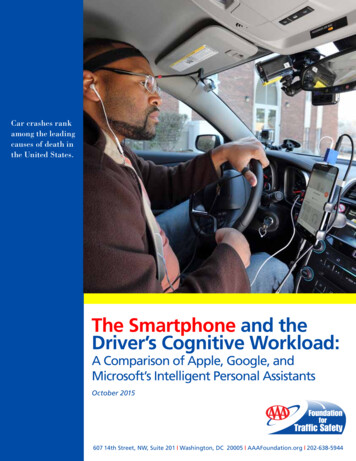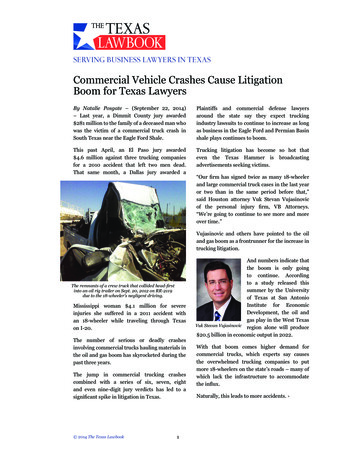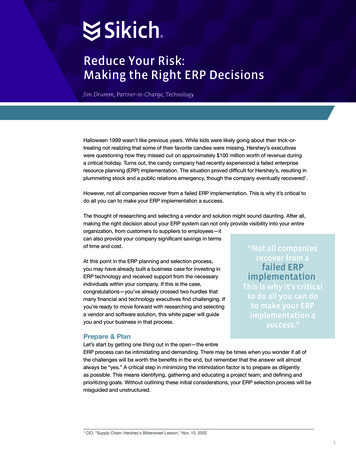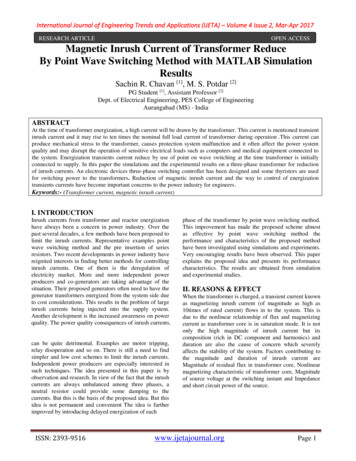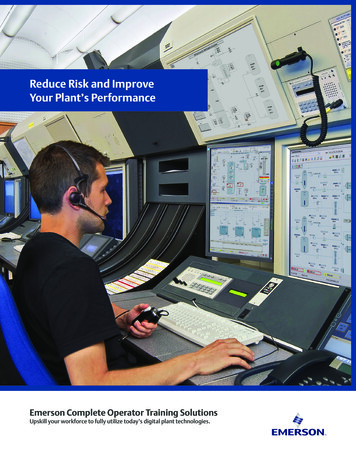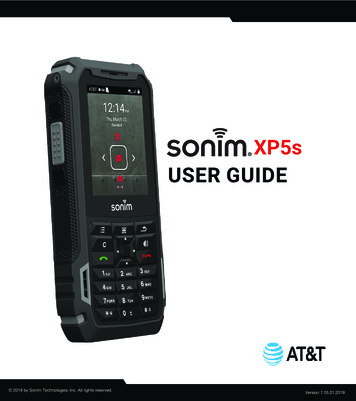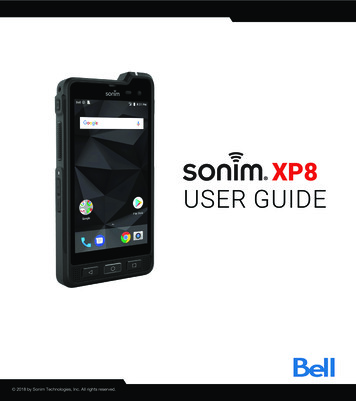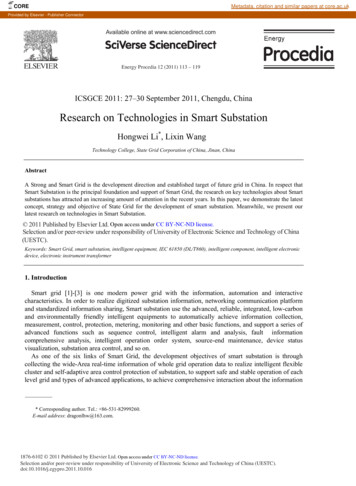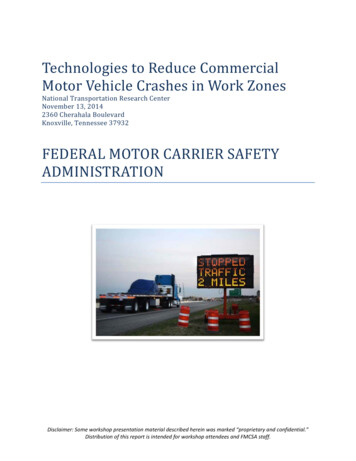
Transcription
Technologies to Reduce CommercialMotor Vehicle Crashes in Work ZonesNational Transportation Research CenterNovember 13, 20142360 Cherahala BoulevardKnoxville, Tennessee 37932FEDERAL MOTOR CARRIER SAFETYADMINISTRATIONDisclaimer: Some workshop presentation material described herein was marked “proprietary and confidential.”Distribution of this report is intended for workshop attendees and FMCSA staff.
2MEETING DETAILSThe meeting was held from 8:30 am to 12:30 pm on November 13, 2014. Oak Ridge NationalLaboratory (ORNL) provided logistical support to FMCSA in arranging and hosting the event, andthe meeting was conducted at the National Transportation Research Center (Knoxville, TN).Chris Flanigan, Federal Motor Carrier Safety Administration (FMCSA) Program Manager for theCommercial Motor Vehicle Roadside Technology Consortium (CMVRTC) led the overall meeting,which included representatives from several State Departments of Transportation and Safetyincluding, Georgia, Kentucky, Louisiana, North Carolina, and Tennessee. Federal officialspresent included Jack Van Steenburg (FMCSA Chief Safety Officer and Assistant Administrator),Dr. Kelly Regal (FMCSA Associate Administrator for Research and Technology), Dr. Steven Smith(Director of Analysis, Research, and Technology), as well as State-based FMCSA and FederalHighway Administration (FHWA) staff.PURPOSE OF MEETINGThe purpose of the meeting was to convene an overview of current State efforts to address thisissue; to understand solutions that could be provided through existing commercial mobile radioservices (CMRS) systems in commercial motor vehicles (CMVs); and to identify specific researchareas that will need to be addressed to deploy such a solution.AGENDAThe agenda was constructed to offer participants perspectives on implementation ofcommercial vehicle safety in work zones from Federal, State and private sector/industrystakeholders.8:30 AM: Welcome and Introductions: Chris Flanigan, Program Manager, FMCSA.8:45 AM: Technology Applications to Prevent Work Zone CMV Crashes: Jack Van Steenburg,Assistant Administrator and Chief Safety Officer, FMCSA.9:15 AM: Current State Activities: Colonel Tracy Trott, Tennessee Highway Patrol (THP). Lieutenant Anthony Back, North Carolina Department of Public Safety. Barry Lacy, Claims/Work Zone/Audit Engineer, Louisiana Department ofTransportation.10:00 AM: Federal Highway Administration Activities: Todd Peterson, Transportation Specialist,Work Zone Management, Federal Highway Administration.10:30 AM: Break.
310:45 AM: Available Solutions Using Commercial Mobile Radio Services: Hass Machlab, President, Innovative Software Engineering.Rick Ochsendorf, Senior Vice President, Operations and ProductManagement, PeopleNet.Tom Cuthbertson, Vice President, Regulatory Compliance, XRS Corporation.Brian Heath, President, Intelligent Imaging Systems.11:45 AM: Discussion and Next Steps, Moderator–Gary Capps, Technical Director, CMVRTC,ORNL.12:30 PM: Adjourn.DISCUSSION BY TOPICAL AREAS Chris Flanigan gave the Welcome and Introductions of key representatives fromgovernment, industry, and academia. The attendees self-introduced around the roombefore the meeting sessions commenced. Jack Van Steenburg, Assistant Administrator and Chief Safety Officer, FMCSA, gave thecharge to the attendees to prevent work zone CMV crashes with technologyapplications. He cited 609 fatalities occurred in work zones in 2013, with 25 percentinvolving commercial vehicles. While a nominally small statistic in comparison to totalmotor vehicle accidents, Jack Van Steenburg recognized the importance of each one inhuman terms. He disclosed the availability of 25M in Commercial Vehicle InformationSystem Networks (CVISN) grants to States commencing in December 2014, includingprovisions for work zone safety improvement.STATE PRACTICES Colonel Tracy Trott, THP, briefed the group on Tennessee’s implementation plan forNational Traffic Incident Management (TIM) Responder Training and announced theState’s newest facility for providing this training. Citing national statistics that suggestone law enforcement officer is struck and killed each month while in an incidentresponse setting, and secondary work zone crashes are some of the “worst they’ve everseen.” In the field, THP endeavors to minimize their exposure and clear disabled vehicleswithin 30 minutes (statistics reveal that each minute increases the chance of asecondary crash incident by 2.8 percent). The TIM primarily focuses on the safety oftheir staff, but collateral protection is provided to other affected parties like emergencymedical technicians, fire, tow truck, highway workers that have greater risk of death( 200 sum/year nationwide) via timely coordination. He related that the TennesseeHighway Patrol incorporates a 4-hour course into their academy curriculum using multi-
4disciplinary instructors. Using FHWA grant funds, Tennessee’s new TIM respondertraining site was opened in 2014 and is available to agencies that would like to use it. Itincludes over 1,800 feet of dedicated pavement for simulation of traffic incidents(crashes, felony stops, work zones) in mock actual traffic settings (Figure 1). It can alsobe utilized for controlled field evaluation of work zone safety warning devices andequipment.Fig. 1. State of TN Traffic Incident Management trainingsite features. Lieutenant Anthony Back from the North Carolina State Highway Patrol (NCSHP) gave anoverview of the work zone practices being conducted within his State by the NorthCarolina Department of Public Safety. The effectiveness of these hinges foremost onplanning and communication. Planning phases include standardized work zone designaugmented with traffic count estimations and accommodation of the work zonepractices. Communications mechanisms include public means (news outlets), variablemessage signs and digital real time information systems. Execution of work zone safetyinvolves highly visible NCSHP presence and incident management patrol trucks for quickresponse in accident handling and removal. Lt. Back described results of a study whichprobed aspects of emerging Vehicle to Vehicle (V2V) and Vehicle to Infrastructures (V2I)technologies and their potential to warn motorists of work zone activities. Even existingCMRS could have a quickly implemented impact. He cited a need for portable roadside
5equipment to supplement satellite communications to alert motorists in real time ofaltered traffic conditions or maintenance activities. Barry Lacy, Claims/Work Zone/Audit Engineer, for Louisiana Department ofTransportation & Development presented his State’s road contractor policies which areused to mitigate work zone crashes. These include mandatory flaggers, traffic controltechnicians, and traffic control supervisors. Stiff penalties and consequences can beenforced if these policies are not followed or contractor training lapses, etc.FEDERAL HIGHWAY ADMINISTRATION (FHWA) ACTIVITIES Todd Peterson, Transportation Specialist, Work Zone Management for FHWA, presentedthe Agency’s initiatives for addressing large truck safety in work zones. Peterson notedthe emerging appearance of a plateau effect (Figure 2) in an otherwise steady decline oftruck work zone crashes for much of the post-2005 period. He addressed viable causesfor the observations including changes in driver behavior, increased truck exposure, andunderlying data issues. It was noted that 80 percent of Caltran and Maryland work zone“closures” are phantom due to over-reporting duration of work zones for having anactive work zone up—but not “filed with the system” beforehand. Some trouble spotsare constantly moving—such as pavement marking.
6Fig. 2. FARS data considered in a closer look at truck crash statistics in workzones. One of the observations arising from ongoing Texas TransportationInstitute study of national truck crash statistics effort is that trucks appear tobe overrepresented in work zone crashes.As most work zone fatal crashes involving trucks are typically rear-end crashes, hedescribed applicability for work zone Intelligent Transportation System (ITS) tools, suchas queue-warning systems (QWS) (see Figure 3) and Freight Advanced TravelerInformation System (FRATIS) 1 (see Figure 4). FRATIS is designed to enhance travelerinformation systems to address specific freight needs for long- and short-haul goodsmovement. The application will provide traveler information to freight operators anddrivers, such as real-time travel estimates with route guidance to freight facilities, andbasic incident alert, road closure, and work zone information. Enhanced freight-specificinformation could include oversize/overweight route restrictions with associated timeperiods, tailored weather information, intermodal connection information, containerdisposition, and shipment schedule updates. This information will support moreefficient freight operations resulting in reduced traffic congestion and increased airquality in metropolitan areas.1Developing ITS Mobility Applications for Freight Operations – [Source:http://www.camsys.com/kb experts ITS mobility.htm#sthash.HJEGrmxk.dpuf]
7Fig. 3. ITS work zone tool Queue Warning Systems (QWS).Fig. 4. ITS work zone tool Freight Advanced Traveler Information System (FRATIS).ILLUSTRATIVE DISCUSSION OF I-35 TRAVELER INFORMATION MANAGEMENT SYSTEMTodd Peterson called upon attendee Gerald Ullman, Ph.D., Senior Research Engineer,from Texas A&M Transportation Institute (TTI) to help describe a pilot testbed forFRATIS that functions in a work zone safety notification capacity. The 96-mile I-35freight corridor between Austin and Dallas, TX services about 25,000-30,000 heavytrucks daily, and is in the midst of a lane-widening upgrade. During the cosntructionperiod, the Texas DOT (TxDOT) is utilizing data collection and dissemination to: Provide advance notification of planned lane closures and their anticipatedimpacts. Provide travelers with predicted delays for construction closures. Provide real-time traveler information (travel time, delays, queues).
8The system integrates information obtained from Bluetooth-sensed monitoring of trafficmovement (every 2–3 miles), 17 spot speed and volume sensors, and 7 digital camerasto analyze travel time and delays. Information is provided back to road users via 21portable dynamic message signs. A Web-based travel pre-planning and currentinformation tool is also accessible (See Figure 4).Fig. 5. Texas Department of Transportation’s design during I-35Traveler Information During ConstructionThe sophisticated architecture of the system was discussed at length, and Jeff Loftus remarkedon the need for implementing a National ITS Reference Architecture for truck and motorcoachsafety standards.Todd Peterson closed by further enumerating FHWA’s targeted conventional outreach effortsto stakeholder groups through dedicated webinars and topical events such as this workshop.COMMERCIAL SOLUTIONS USING CMRS: Hass Machlab, President of Innovative Software Engineering (ISE) presented ISE’stechnical approach to mitigate work zone crashes which relies upon in-cab notificationof CMV drivers prior to encountering congestion and/or work zones. Hass Machlabnoted that work zones are generally fixed and known in advance, while congestion isdynamic in nature and not always predictable. Hass Machlab mapped data flow frominformation sources, through accessible pathways to drivers (and their manifestation asaudio/visual alerts, live navigation updates, etc.). A telematics-based road information
9 consolidation service could effectively integrate and manage the various data handlingmodes. Machlab argued the Government (in collaboration with industry) can help byproviding a path forward to road data consolidation and dissemination via host-basedservices, geo-fence based services, etc.Rick Ochsendorf, Senior Vice President, Operations and Product Managementdiscussed PeopleNet solutions. Their architecture is cloud-based with a variety of mobilegateway feeds. Their foundational product is focused on hours-of-service complianceand efficient use of driver time. Rick Ochsendorf articulated that global positioningsystem (GPS) geo-fences, while a common feature of many fleet management serviceofferings, offer a unique set of challenges for dynamic incident alert and responsesituations. The most problematic challenges are establishing meaningful (i.e., not selfdefeating) geo-fenced area configurations and getting the notification information intothe cabin of affected vehicles. Rick Ochsendorf also revealed some CMV-mounted videocamera technology, enhancing driver ability to distinguish proximate threats. PeopleNetalso claimed to have an approach for auto-subdividing geo-fence into a few stages ofwarnings.Tom Cuthbertson, Vice President, Regulatory Compliance, XRS Corporation discussedproactive notification mechanisms for work zones. Tom Cuthbertson drew upon ananecdotal example illustrating the range of highway incidents, which were encountered(multiple road work zones and a post- high speed chase arrest (traffic stop) in arelatively short 4-hour period. While law enforcement officer (LEO) presence was noted,in no case did Tom Cuthbertson observe any of the information finding its way(uploaded) onto the popular app Google Maps. He noted the elasticity of time delayswhich can be experienced by other users under such congestion-inducing variables aslocation, time-of-day, and severity of the incident. Tom Cuthbertson offered several keycriteria for considering notification management, which suggested a Federally-overseencentral database/clearinghouse. Additional features and desirable attributes of anotification mechanism were also listed, and he noted that all were available (thoughmostly unintegrated) in the marketplace today. Some GPS latency issues are identifiablefor certain modes of tracking incidents and nearby CMVs. Brian Heath, President, Intelligent Imaging Systems, highlighted Drivewyze work zonenotification solutions. Drivewyze is a “smart mobility services” provider for thetransportation industry (and a subsidiary of Intelligent Imaging Systems Inc.). With afoundational product utilizing CMRS smart transponders (coupled with electroniclogging devices) to enable at weigh station bypass convenience for trucks, Drivewyzeadvocated a CMRS-based approach to work zone safety warnings. Heath cited costeffectiveness, functionality, and market penetration of CMRS services and in-cabequipment as enablers. In addition, he noted the need for designing incomponent/system interoperability through hardware and software neutrality. Heathfurther addressed the market implementation barriers which have to be surmounted:
10value proposition for the owner/operator, market readiness, regulatory/lawenforcement (LE) agency readiness, and an attractive service provider business model.WORKSHOP WRAP-UPChris Flanigan wrapped up the half-day meeting with some input from the audience. Discussionpoints included: Technology is available, but will take effort to adapt for work zone applications.Need to include CMV drivers as a stakeholder voice when developing these systems.Will need research funds to help address this matter.Need to address privacy and security issues for these services.Carl Anderson (FHWA Connected Vehicle Program Manager) announced a Call for Proposalsthat will go out early calendar year (CY) 2015 and will be seeking establishment of deploymenttest-beds for the purpose of demonstrating how to build, operate, and maintain connectedvehicle environments at city-scale. Carl Anderson noted that some of the anticipatedsolicitation awards would be looking for niche applications such as work zone safety for CMVs.ITS Joint Program Office support contractor Noblis had elucidated five scenarios for ConnectedVehicles (available via podcasts): freight, corridor, rural, urban, etc., are keywords.Chris Flanigan invited the audience to ruminate on the great discussions and come prepared todiscuss in greater detail at the Commercial Vehicle Safety Alliance (CVSA) meeting next year:National Symposium on Work Zones and Large Trucks 2015 CVSA Workshop (April 13, 2015, inJacksonville, FL). The objective of the workshop is to provide a forum to convene the CMVindustry, DOTs, law enforcement agencies, traffic safety advocates, partners, and stakeholdersto share experiences and ideas, and to identify prospective solutions to improve work zoneeffectiveness and efficiency of the core system components: driver, vehicle, and highway. Theworkshop’s invited attendance is being managed by FHWA.PERCEPTIONS / INTERPRETATIONS:ORNL offers the following perceptions and interpretations from the workshop to augmentFMCSA program planning: There is a need for a survey of available data sources and integrators, to wit: GPSw/traffic, Google Maps, Bing Maps, TDOT Web site, Waze, Zipdash, TomTom, Yahoo,MapQuest, INRIZ, NAVTEQ. Most companies get traffic data from cell phone GPS. A spot
11survey of two commonly-used systems: (1) MapQuest (see Figure 6) and (2) Bing (seeFigure 7) show the presumed disparity in information.Fig. 6. MapQuest map displaying traffic information forKnoxville, TN (http://www.mapquestapi.com/traffic/). [Notethe Start/End times are estimated and cover a large range.]
12Fig. 7. Bing map displaying traffic information for Knoxville, 6.This data call returns nothing for Knoxville, so there are definitely gaps in coverage dependingon source. Institute a hardware-based mechanism so that when law enforcement or otheremergency workers activate their vehicle emergency lighting, trucks within a 2-, 5-, oreven 10-mile radius out are warned about it in-cab.Need to standardize XML file format for all States’ work zones.System solutions should archive historical data—like precise timing of crash fromreports compared to timing that was shown (if at all) on Google, Bing, TDOT, etc.o Cursory–manually spot check some.o Advanced–automate.(Alan internal) make an “aggregator” system like Visualizing Energy ResourcesDynamically on Earth (VERDE)/Energy Awareness and Resiliency Streaming Service(EARSS) that scrapes Web sites (Google, Bing, MapQuest), State DOTs, even Twitter. Thisis used by first responders in preparation for things like hurricanes.
13Appendix A: AttendeesFirst NameLast NameOrganizationCarlAndersenFHWA, Connected Vehicle Program ManagerAnthonyTonyBackBarhamLieutenant, North Carolina Department of Public SafetyCaptain, TN Highway PatrolAlanBarkerOak Ridge National LaboratoryJoeRandyBarryBoylesInnovative Software EngineeringPeopleNetGaryCappsOak Ridge National LaboratoryTomBrandonCuthbertsonDouglasXRS Corp.Lieutenant, TN Highway PatrolMarkFredDunlapFakkemaFMCSA -- Mississippi DivisionZonar SystemsChrisFlaniganFMCSA, Office of Analysis, Research, and TechnologyOscarDonLindaFranzeseGedgeGoodmanOak Ridge National LaboratoryTDOTFMCSA -- Kentucky DivisionJohnRobertHallHancockTDOTMississippi Department of Public SafetyEarlHardyFMCSA, Sr. Policy Advisor, Office of the Assistant Administrator andChief Safety vewyzeCaptain, Kentucky State PoliceLaw Enforcement Administrator, Governors Highway SafetyAssociationDirector, Mississippi Department of TransportationHarmonDavidHunsickerJacksonCaptain, Metro Nashville PoliceIntelligent Imaging SystemsSamuelJohnsonOfficer, Metro Nashville PoliceKeithKahlOak Ridge National LaboratoryTomBarryKellyLacyFMCSA, National CVISN Program ManagerLouisiana Department of WA, Office of Operations Research and DevelopmentMississippi Department of Public SafetyFMCSA, Technology Division ChiefHassBrianMachlabMoffordInnovative Software EngineeringDrivewyze
14First NameLast NameOrganizationSheilaRickMooreOchsendorfOak Ridge National LaboratoryPeopleNetToddPetersonFHWA, Office of Transporta
Nov 13, 2014 · discussed PeopleNet solutions. Their architecture is cloud-based with a variety of mobile gateway feeds. Their foundational product is focused on hours-of-service compliance and efficient use of driver time. Rick Ochsendorf articulated that global positioning system (GPS) geo-fences
